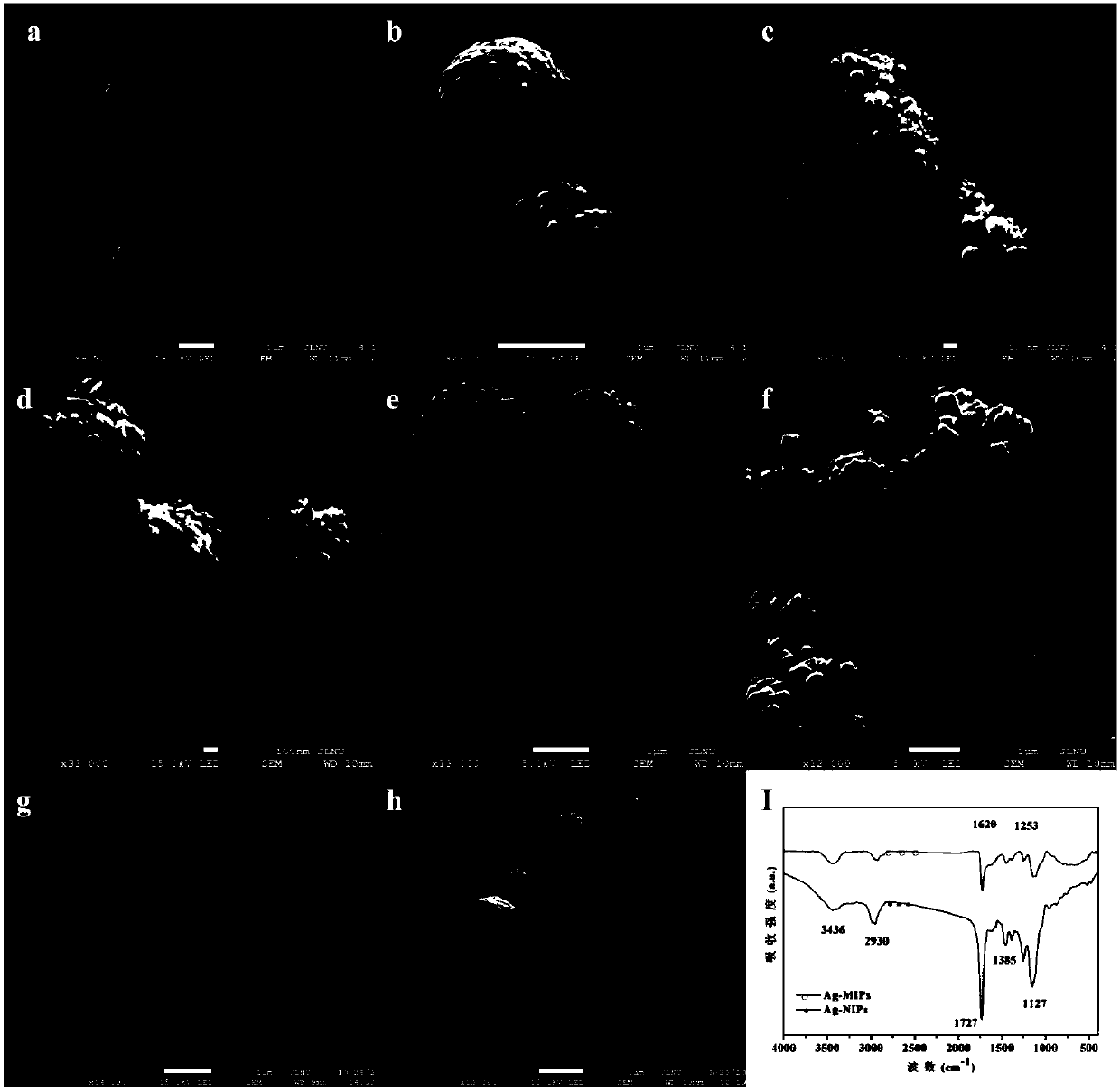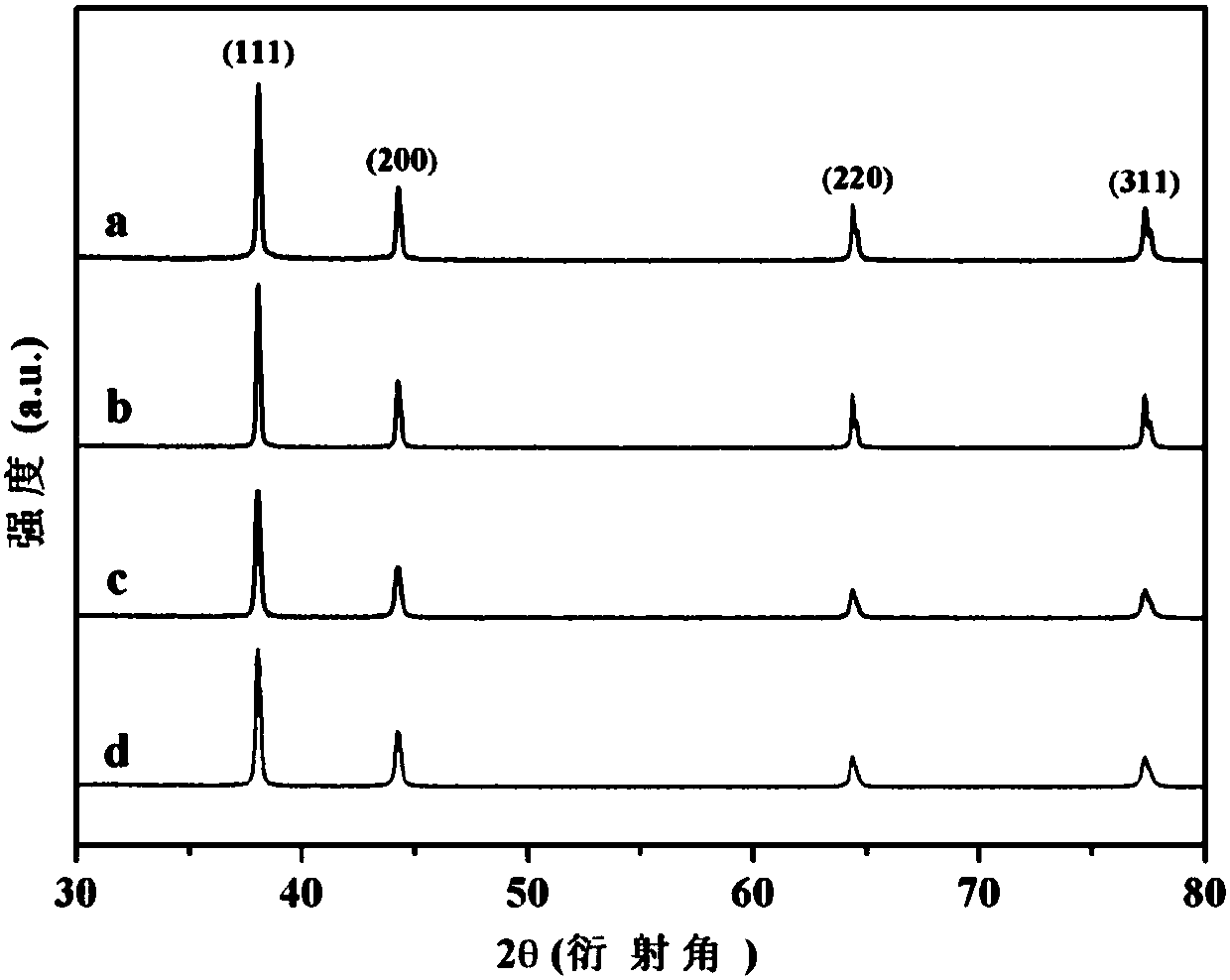Preparation method and application of molecular imprinted sensor with SERS (Surface Enhanced Raman Scattering) activity
A technology of molecular imprinting and sensors, which is applied in the field of preparing molecular imprinting sensors with SERS activity to detect pyrethroids, can solve the problems of ignoring the complexity of components, achieve stable physical and chemical properties, high detection sensitivity, and broaden the application field.
- Summary
- Abstract
- Description
- Claims
- Application Information
AI Technical Summary
Problems solved by technology
Method used
Image
Examples
Embodiment 1
[0036] (1) Preparation of Ag nanoparticles with different shapes
[0037] In a 50mL single-necked flask, 1.0mL of 1.0mol L -1 AgNO 3 solution and 0.25mol L -1 The acid solution (citric acid and mandelic acid) was added to 9.0mL deionized water under stirring conditions, and 1.0mL of 1.0mol L -1 VC, continue stirring. After the reaction, it was repeatedly washed, centrifuged, and dried for later use.
[0038] (2) Preparation of Molecularly Imprinted Sensors of Ag-MIPs
[0039] In a 100mL single-necked flask, 1.0g of Ag nanoparticles with different morphologies were dispersed into a mixed solution of 40mL toluene and 1.0mL MPS, and a sufficient amount of N 2 To exclude oxygen in the solution; after 9.0 hours, the synthesized product was centrifuged, washed with ethanol three times, and dried in vacuum to obtain solid A for use.
[0040] Disperse 100mg of solid A into 50mL of acetonitrile, sonicate thoroughly, then add 0.1mmol LC, 0.3mmol AM and 1.0mmol EGDMA into the solut...
Embodiment 2
[0045] (1) Preparation of Ag nanoparticles with different shapes
[0046] In a 50mL single-necked flask, 1.0mL of 1.0mol L -1 AgNO 3 solution and 0.25mol L -1 The acid solution (citric acid and mandelic acid) was added to 10mL deionized water under stirring conditions, and 1.0mL 1.0mol L -1 VC, continue stirring. After the reaction, it was repeatedly washed, centrifuged, and dried for later use.
[0047] (2) Preparation of Molecularly Imprinted Sensors of Ag-MIPs
[0048] In a 100mL single-necked flask, 1.0g of Ag nanoparticles with different morphologies was dispersed into a mixed solution of 50mL toluene and 2.0mL MPS, passing a sufficient amount of N 2 To exclude oxygen in the solution; after 10 hours, the synthesized product was centrifuged, washed three times with ethanol, and dried in vacuum to obtain solid A for use.
[0049] Disperse 100mg of solid A into 60mL of acetonitrile, sonicate thoroughly, then add 0.2mmol LC, 0.4mmol AM and 1.2mmol EGDMA into the solutio...
Embodiment 3
[0054] (1) Preparation of Ag nanoparticles with different shapes
[0055] In a 50mL single-necked flask, 1.0mL of 1.0mol L -1 AgNO 3 solution and 0.25mol L -1 The acid solution (citric acid and mandelic acid) was added to 11mL of deionized water with stirring, and 1.0mL of 1.0mol L -1 VC, continue stirring. After the reaction, it was repeatedly washed, centrifuged, and dried for later use.
[0056] (2) Preparation of Molecularly Imprinted Sensors of Ag-MIPs
[0057] In a 100mL single-necked flask, 1.0g of Ag nanoparticles with different shapes were dispersed into a mixed solution of 60mL toluene and 3.0mL MPS, and a sufficient amount of N 2 To exclude oxygen in the solution; after 11 hours, the synthesized product was centrifuged, washed with ethanol three times, and dried in vacuum to obtain solid A for use.
[0058] Disperse 100 mg of solid A into 70 mL of acetonitrile, sonicate thoroughly, then add 0.3 mmol LC, 0.5 mmol AM and 3.0 mmol EGDMA into the solution, pass N ...
PUM
 Login to View More
Login to View More Abstract
Description
Claims
Application Information
 Login to View More
Login to View More - R&D
- Intellectual Property
- Life Sciences
- Materials
- Tech Scout
- Unparalleled Data Quality
- Higher Quality Content
- 60% Fewer Hallucinations
Browse by: Latest US Patents, China's latest patents, Technical Efficacy Thesaurus, Application Domain, Technology Topic, Popular Technical Reports.
© 2025 PatSnap. All rights reserved.Legal|Privacy policy|Modern Slavery Act Transparency Statement|Sitemap|About US| Contact US: help@patsnap.com



